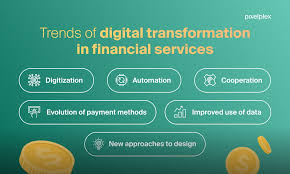Introduction
Digital transformation in financial services refers to the integration of digital technology into all areas of banking, insurance, and investment, fundamentally changing how businesses operate and deliver value to customers. In 2024, the financial sector is experiencing unprecedented changes driven by technological advancements, evolving customer expectations, and regulatory pressures. This transformation is not just about adopting new technology; it's about reimagining processes, strategies, and the overall customer experience to stay competitive in a rapidly changing market.
Importance
Digital transformation is critical for financial institutions for several reasons:
Customer Experience: As customers increasingly demand seamless and personalized services, digital transformation enables financial institutions to offer improved user experiences across various channels, enhancing customer satisfaction and loyalty.
Operational Efficiency: By automating processes and leveraging data analytics, financial institutions can significantly reduce operational costs and improve efficiency, allowing them to allocate resources more effectively.
Innovation and Competitiveness: Embracing digital transformation fosters innovation, enabling financial institutions to stay ahead of competitors and meet the challenges posed by new entrants such as fintech startups and technology giants.
Regulatory Compliance: Digital transformation helps institutions keep up with regulatory requirements by adopting advanced technologies like RegTech for compliance and risk management.
Financial Inclusion: Digital platforms can reach underserved populations, providing access to financial services and promoting financial inclusion.
Strategic Drivers
- Customer-Centric Approach: Increasing focus on personalized customer experiences and services.
- Omnichannel Experience: Integration of various digital channels for seamless customer interaction.
- Operational Efficiency: Streamlining processes to reduce costs and improve service delivery.
- Agile Methodologies: Adoption of agile practices for faster product development and innovation.
- Data-Driven Decision Making: Leveraging data analytics to drive strategic decisions.
- Customer Feedback Loops: Incorporating customer feedback into product and service improvements.
- Partnerships and Collaborations: Collaborating with fintech companies to leverage innovative solutions.
- Digital-First Strategy: Prioritizing digital over traditional channels for growth.
- User Experience (UX) Design: Focusing on intuitive and engaging design for digital platforms.
- Global Expansion: Utilizing digital tools to expand into new markets more efficiently.
Technological Drivers
- Artificial Intelligence (AI): Using AI for predictive analytics, customer service, and fraud detection.
- Machine Learning (ML): Enhancing risk management and customer insights through ML models.
- Blockchain Technology: Implementing blockchain for secure transactions and smart contracts.
- Cloud Computing: Leveraging cloud services for scalability and flexibility.
- Robotic Process Automation (RPA): Automating repetitive tasks to increase efficiency.
- Internet of Things (IoT): Connecting devices to gather data for enhanced decision-making.
- 5G Technology: Enabling faster and more reliable mobile connectivity.
- Quantum Computing: Exploring quantum computing for advanced data processing capabilities.
- Cybersecurity Innovations: Implementing advanced security measures to protect digital assets.
- Biometric Authentication: Enhancing security through biometric identification methods.
- APIs and Open Banking: Facilitating third-party integrations and open banking initiatives.
- Natural Language Processing (NLP): Improving customer interactions with chatbots and virtual assistants.
- Edge Computing: Reducing latency and enhancing data processing at the edge.
- Digital Twins: Using digital twins for risk modeling and scenario analysis.
- Augmented Reality (AR) and Virtual Reality (VR): Enhancing customer engagement and training.
- Big Data Analytics: Leveraging large datasets for insights and forecasting.
- Decentralized Finance (DeFi): Exploring decentralized platforms for financial services.
- Low-Code/No-Code Platforms: Accelerating application development with minimal coding.
- Wearable Technology: Utilizing wearables for biometric data collection and insights.
- Smart Contracts: Automating contract execution through blockchain technology.
Regulatory Drivers
- Data Privacy Regulations: Complying with GDPR, CCPA, and other privacy laws.
- Anti-Money Laundering (AML): Implementing technology to enhance AML compliance.
- Know Your Customer (KYC): Streamlining KYC processes with digital tools.
- PSD2 and Open Banking Regulations: Adapting to open banking regulatory requirements.
- Financial Conduct Authority (FCA) Regulations: Adhering to FCA guidelines for digital services.
- Regulatory Sandboxes: Utilizing regulatory sandboxes for testing innovative solutions.
- International Financial Reporting Standards (IFRS): Aligning digital strategies with IFRS.
- Environmental, Social, and Governance (ESG) Compliance: Integrating ESG factors into digital strategies.
- Cybersecurity Regulations: Meeting cybersecurity standards and regulations.
- Consumer Protection Laws: Ensuring digital solutions comply with consumer protection laws.
- Digital Identity Verification: Implementing secure digital identity verification processes.
- Tax Compliance: Adopting digital solutions for efficient tax compliance.
- Basel III and IV: Aligning digital strategies with Basel III and IV requirements.
- Cross-Border Regulations: Navigating cross-border regulatory challenges for digital services.
- InsurTech Regulations: Adapting to regulatory changes in the insurance technology sector.
- Fintech Charter and Licensing: Securing fintech charters and licenses for digital operations.
- Digital Payments Regulation: Complying with regulations related to digital payments.
- Crypto Asset Regulations: Navigating regulations surrounding cryptocurrency and digital assets.
- Prudential Regulation Authority (PRA) Guidelines: Ensuring compliance with PRA guidelines.
Market-Driven Drivers
- Increased Competition: Responding to competition from fintech startups and tech giants.
- Customer Expectations: Meeting evolving customer expectations for digital services.
- Fintech Innovations: Adopting innovations from fintech disruptors.
- Digital Payment Solutions: Expanding digital payment offerings to meet demand.
- Financial Inclusion: Leveraging digital solutions to promote financial inclusion.
- Millennial and Gen Z Demand: Catering to younger generations with digital preferences.
- Sustainability Initiatives: Integrating sustainability into digital transformation strategies.
- Shift to Remote Work: Adapting to remote work with digital tools and platforms.
- Rise of Gig Economy: Providing financial solutions tailored to gig economy workers.
- Personal Finance Management: Offering tools for personal finance management and education.
- Digital Wealth Management: Expanding digital wealth management services.
- Customer Loyalty Programs: Enhancing customer loyalty through digital engagement.
- Alternative Lending Platforms: Embracing alternative lending solutions and platforms.
- Microservices Architecture: Adopting microservices for flexible and scalable systems.
- Subscription-Based Models: Exploring subscription-based financial services.
- Customer Retention Strategies: Implementing digital strategies to improve customer retention.
- Mobile-First Solutions: Prioritizing mobile solutions for customer engagement.
- Digital Banking Platforms: Expanding digital banking capabilities and offerings.
- Enhanced Customer Analytics: Utilizing analytics for deeper customer insights.
- Cross-Industry Partnerships: Collaborating with other industries for innovative solutions.
- AI-Driven Personalization: Offering personalized services through AI-driven insights.
Emerging Trends and Innovations
- Decentralized Applications (DApps): Developing decentralized applications for financial services.
- Crypto Custody Solutions: Providing secure custody solutions for cryptocurrencies.
- Securitization of Digital Assets: Exploring securitization of digital assets for investment.
- Tokenization of Assets: Implementing tokenization for liquidity and fractional ownership.
- Peer-to-Peer (P2P) Lending: Expanding P2P lending platforms and services.
- Digital Asset Management: Offering digital asset management solutions.
- AI-Powered Risk Assessment: Enhancing risk assessment with AI tools.
- Voice-Activated Banking: Implementing voice recognition for banking transactions.
- Predictive Analytics for Credit Scoring: Using predictive analytics for credit risk assessment.
- Smart ATMs: Deploying smart ATMs with enhanced functionalities.
- Digital-Only Banks: Launching digital-only banks for a streamlined experience.
- AI-Based Fraud Detection: Improving fraud detection with AI algorithms.
- Sustainable Finance Solutions: Offering solutions aligned with sustainable finance goals.
- Real-Time Payments: Implementing real-time payment systems.
- Crowdfunding Platforms: Expanding crowdfunding options for businesses and individuals.
- RegTech Solutions: Adopting regulatory technology for compliance automation.
- Digital Loan Origination: Streamlining loan origination processes digitally.
- Virtual Branches: Establishing virtual branches for customer engagement.
- AI-Powered Investment Platforms: Leveraging AI for automated investment advice.
- Multi-Cloud Strategies: Implementing multi-cloud strategies for flexibility and resilience.
- Digital Ecosystems: Building digital ecosystems for financial services.
- Hyper-Personalization: Offering hyper-personalized services based on data insights.
- Cross-Border Payment Solutions: Expanding cross-border payment offerings.
- Digital Insurance Platforms: Developing digital platforms for insurance services.
- AI-Powered Trading: Utilizing AI for algorithmic trading and analysis.
- Contactless Payment Solutions: Expanding contactless payment options.
- InsurTech Partnerships: Collaborating with InsurTech companies for innovative solutions.
- Crowdsourced Innovation: Leveraging crowdsourced ideas for product development.
- Remote Advisory Services: Offering remote financial advisory services.
- AI-Driven Credit Scoring: Implementing AI-driven credit scoring models.
- Decentralized Exchanges (DEXs): Exploring decentralized exchanges for cryptocurrency trading.
Pros
The benefits of digital transformation in financial services are manifold:
Enhanced Customer Insights: Advanced data analytics enable institutions to gain deeper insights into customer behavior, allowing for more personalized and targeted offerings.
Improved Security: Implementing cutting-edge cybersecurity measures and biometric authentication helps protect customer data and build trust.
Scalability: Cloud computing and other digital tools provide financial institutions with the scalability needed to grow and adapt to market changes.
Innovation: Digital transformation encourages the development of new products and services, such as mobile banking apps, digital wallets, and AI-powered investment platforms.
Cost Savings: Automation and process optimization lead to significant cost reductions, freeing up resources for strategic investments.
Cons
Despite its advantages, digital transformation also presents challenges:
Cybersecurity Risks: As financial institutions digitize, they become more susceptible to cyberattacks, requiring robust security measures and constant vigilance.
Implementation Costs: The initial investment in digital transformation can be substantial, posing a challenge for smaller institutions with limited budgets.
Complexity of Integration: Integrating new digital solutions with legacy systems can be complex and time-consuming, potentially disrupting operations.
Regulatory Challenges: Navigating a complex regulatory landscape while implementing digital changes requires careful planning and resources.
Talent Shortage: The demand for skilled professionals in AI, cybersecurity, and data analytics often exceeds supply, leading to a talent shortage.
Conclusion
Digital transformation in financial services is a double-edged sword, offering immense opportunities and significant challenges. The future success of financial institutions depends on their ability to embrace technological innovations, prioritize customer experiences, and navigate regulatory landscapes effectively. By doing so, they can enhance operational efficiency, drive innovation, and maintain competitiveness in a digital-first world. These drivers reflect the dynamic nature of the financial services industry in 2024, with a strong emphasis on innovation, customer-centricity, and compliance. By embracing these trends, financial institutions can enhance their digital capabilities and remain competitive in an increasingly digital landscape.
Thank You
Thank you for exploring the key drivers and implications of digital transformation in financial services. As we look towards the future, it's clear that the ability to adapt and innovate will be crucial for success in the rapidly evolving financial landscape.
If you have any questions or need further information, feel free to ask!







.jpg)